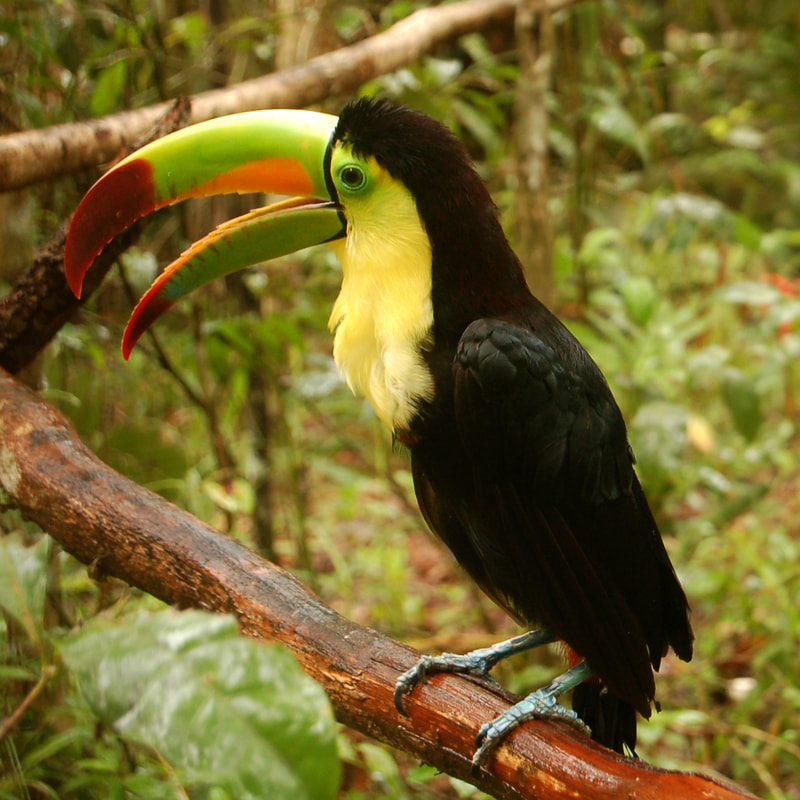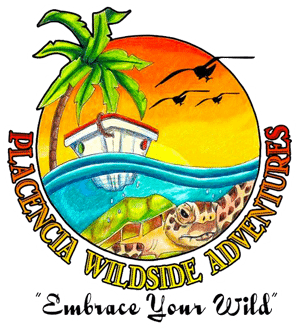|
There is all kinds of reasons to visit Belize. There is an abundant supply of natural beauty, from stunning beaches, islands (or Cayes), Mayan ruins, snorkeling, diving, a barrier reef, rainforest, rivers, rolling mountains, national parks, and birds. Belize has some of the most exotic birds in the world. There are more than 590 species of birds living witin the Belize borders. Here is (14) birds, worthy of a closer view. 1. SCARLET MACAW Scarlet Macaw - One of 17 species of macaws, the scarlet macaw is one of the most beautiful members of the parrot family and one of the largest Neotropical parrots. Scarlet macaws prefer life in the rainforest. With wide strong wings and hollow bones that aid flight, they can reach speeds of 56 kilometers (35 miles) per hour. There are two subspecies of scarlet macaw that can be found in Mexico and Central and South America. Scarlet macaw inhabits rainforests, woodlands and forested areas near the rivers. Deforestation and illegal collecting from the wild (due to pet trade), are responsible for the sharp decline in the number of scarlet macaws in some parts of their range. Luckily, global population of scarlet macaws are still large and stable and these birds (presently), are not on the list of endangered species. 2. Kelled-Billed Toucan Keel-Billed Toucan - Is large South American bird that belongs to the family of toucans. It can be found from southern Mexico to northern Columbia. Keel-billed toucan inhabits tropical and subtropical rainforests (from the lowlands to the altitude of 6.200 feet). Major threats for the survival of keel-billed toucan are habitat destruction and uncontrolled hunting (because of the meat & beak). Despite these factors, keel-billed toucan is still widespread and numerous in the wild. 3. ROYAL FLYCATCHER Royal Flycather - This is a type of kingbird that belongs to the tyrant flycatcher family. It can be found in North & South America. It inhabits savannas with scattered trees, fields, pastures, areas near the towns, golf courses and scrublands. Unlike for many other birds, deforestation is beneficial for scissor-tailed flycatchers because they prefer open areas. Climate changes, severe storms and tornados are the greatest threats for the survival of nearly hatched birds. Flycatchers are numerous and widespread in the wild. Presently these birds are not on the endangered species list. 4. OCELLATED TURKEY Ocellated Turkey - This is a large, distinct & spectacular gamebird found on the tropical rainforest floor, near brushy fields, and adjacent clearings. Rarely seen away from protected areas, where it can be fairly common and tame. Note the orange head ‘warts,’ copper-colored wing panel, and iridescent blue-and-gold eyespots. It feeds in groups on the ground, and roosts in the trees. 5. MAGNIFICENT FRIGATE Magnificent Frigatebird - The magnificent frigatebird is a large (lightly built sea bird), with brownish-black plumage, long narrow wings and a deeply forked tail. The male has a striking red gular sac, which he inflates to attract a female. The female is slightly larger than the male and has a white breast and belly. Frigatebirds feed on fish taken in flight from (other birds), and sometimes indulge in harassing other birds to force them to regurgitate their food. 6. JABIRU STORK Jabiru Stork - The Jabiru stands five (5) feet tall with wings spanning nine (9) feet, and is considered one of the larger birds found in Belize. The Jabiru Stork is a very rare bird and is endangered throughout it's range. It's habitat range, extends from southeastern Mexico to northern Argentina. Its heavy bill is about 12-inches long and is perfectly designed for catching fish, frogs and snakes. It is the tallest flying bird found in South America. They arrive in Belize from Mexico in November and nest in the tall pines of the savannas and marshes of the Belizean lowlands. They remain in Belize until June or July, flying north with the first rains. 7. HARPY EAGLE Harpy Eagle - This is a massive bird of prey, restricted to mature forest and very rare. They have enormous talons. Adult birds are dark gray (as seen above), paler below, with obvious dark breast band. Note more obvious black-and-white barring on wings in flight to help separate it from Crested Eagle. They feed on monkeys & sloths. Usually seen perched in the canopy or flying across a road or river. These birds can weigh up to 20 pounds and have a 7-foot wingspan making them a formidable predator. In Belize the population is declining due to deforestation, shooting, and nest destruction, resulting in near extinction of this species. However projects like the "Belize Harpy Eagle Restoration Project", in collaboration with Sharon Matola (Founder & Director of The Belize Zoo & The Peregrine Fund) both strive to re-establishment the harpy eagle within Belize. 8. RED-FOOTED BOOBY Red Footed Booby - The red-footed booby is a large sea bird of the booby family. As suggested by the name, adults always have red feet, but the colour of the plumage varies. They are powerful and agile fliers, but they are clumsy in take offs and landings. These birds are famous inhabitants of Half Moon Caye, a natural monument found here in Belize. Nesting starts around mid-December and the young hatch around March. Chicks are full grown in a matter of months and then its off to the open sea. Flying fish are their favourite food, caught at night when the fish are nearer the surface. 9. KING VULTURE King Vulture - The King Vulture, known as "King Jan Kro", and is the largest and most colorful of the four species of vultures found in Belize. The extremely thick and strong bill is well adapted for tearing, and the long, thick claws for holding the meat. The King Vulture inhabit the forested lowlands of Belize. They will sometimes fly over savannas searching for dead meat. Their extremely keen eyesight and sense of smell, allows them to locate potential food sources easily. They will often locate food by the presence of the other vulture species. Once the King Vulture lands, other birds scatter. 10. COLLARD TOUCAN Collard Toucans - The Collared Aracari Toucan is brightly marked and has a large bill. The adult is typically 15.5–16 inches long and weighs 6.7–9.7 ounces. Both sexes are alike in appearance, with a black head and chest, with yellow and red underparts. The Collared Aracari Toucan, is a near-passerine bird which breeds from southern Mexico to Panama. 11. BLUE CROWNED MOT-MOT Blue Crowned Mot-Mot - The Blue Crowned Mot-Mot can be seen throughout Belize. Its habitat is mainly just below the canopy (or top), of the rainforest. The length of the Blue-Crowned Mot-Mot is between 11 & 18 inches (to include the tail). The one feature that most distinguishes almost all motmots is their long tails. Close to the tip of the tail, the barbs are missing for about one inch or more. This gives the appearance not unlike that of a tennis racket. 12. LINEATED WOODPECKER Lineated Woodpecker - They are identified by their flaming red heads, protrouding beaks, and black & white wing feathers. One species of this group lives on Ambergris. Males have a red moustache (as seen in the picture above), this adds to their dramatic, somewhat comical appearance. These are large ‘woody woodpeckers’ of tropical littoral forest in lowlands and foothills. Also ranges into semi-open areas with tall trees, mangroves, and other lightly wooded habitats. 13. GREAT CURASSOW Great Curassow - Very large game bird of tropical forested areas, eliminated mainly from hunting. It can now only be rarely found in protected parks or very remote areas. It is usually seen on the forest floor, singularly or in small groups, feeding among trees. Males often try to impress females by sining high in the canopy, with a very low-pitched, subliminal, booming sound. Both sexes have distinctive curly crest and plumage which varies from colorful to black. 14. YELLOW-HEADED PARROT  Yellow-Headed Parrot Yellow-Headed Parrot Yellow-Head Parrot - The Yellow-head parrot is a subspecies unique to Belize. The most distinctive features of this primarily green parrot, it it's yellow head and the red & yellow patch on each wing (prominent with adult birds). There is also dark blue tips to the flight feathers and yellow tips to the tail feathers. It has a hooked beak, which is used for cracking nuts & seeds, as well as grasping & climbing. It feet are very adapted at grasping, with two toes pointing forward and two toes pointing backward. Their ability to mimic, is what has made them the victims of the illegal pet trade.
0 Comments
Your comment will be posted after it is approved.
Leave a Reply. |
Is located on the island of Ambergris Caye, directly across from the Belize Barrier Reef, off the mainland coast of Belize. The property is nestled in a cluster of Australian Pine trees, backed to a littoral jungle, and surrounded by tropical gardens. It's about a one minute walk from the property to the beach, and a 10-15 minute drive from the island airstrip to the property.
We offer one bedroom suites (455 s.f.) of living area to include: livingroom, kitchenette, private bathroom and bedroom. We are also about a one minute walk from one of the best restaurants on the island serving (breakfast, lunch & dinner). Within walking distance you can find: (3) blocks is Robyn's BBQ (4) blocks is 2 fruit stands (5) blocks local grocery store IF YOU'RE COMING TO BELIZE TO............... If you're coming to Belize to dive the Blue Hole, descend the shelf walls at Turneffe, snorkel the Barrier Reef, explore Mayan ruins, rappel into a cave, kayak along the river through caves, zip line through jungle tree tops, hike through a cave to see an ancient human skeleton, swim with sharks, listen to Howler Monkey's, hold a boa constrictor, feed a jaguar, horseback ride through the jungle, canoe through a cave, rappel down a waterfall, sail around an island, enjoy cocktails & dinner to a sunset, climb 130' feet to the top of a Mayan ruin, rip up the jungle trails on an ATV, float through a series of caves on a tube, and sip on a rum punch..... then this is the place for you. Belize Budget Suites, offers you clean, affordable, attractive, accommodations, at prices that allow you to do all the things just mentioned. Archives
February 2021
Categories
All

For All Your Home Improvement Needs

For all Your Real Estate Needs
501-226-4400 10 Coconut Dr. San Pedro, Belize Your Ad Could Go Here
|

















 RSS Feed
RSS Feed























